Starbucks Sustainability in Netherlands
VerifiedAdded on 2020/06/06
|13
|3293
|127
AI Summary
This assignment requires a comprehensive analysis of Starbucks' sustainability initiatives in the Netherlands. Students are expected to evaluate Starbucks' performance across various dimensions, including environmental impact, social responsibility, and economic contributions. The analysis should consider relevant legislation, consumer preferences, and industry best practices within the Dutch context. A PESTLE analysis and SWOT analysis are recommended for a robust understanding of the external and internal factors influencing Starbucks' sustainability efforts.
Contribute Materials
Your contribution can guide someone’s learning journey. Share your
documents today.
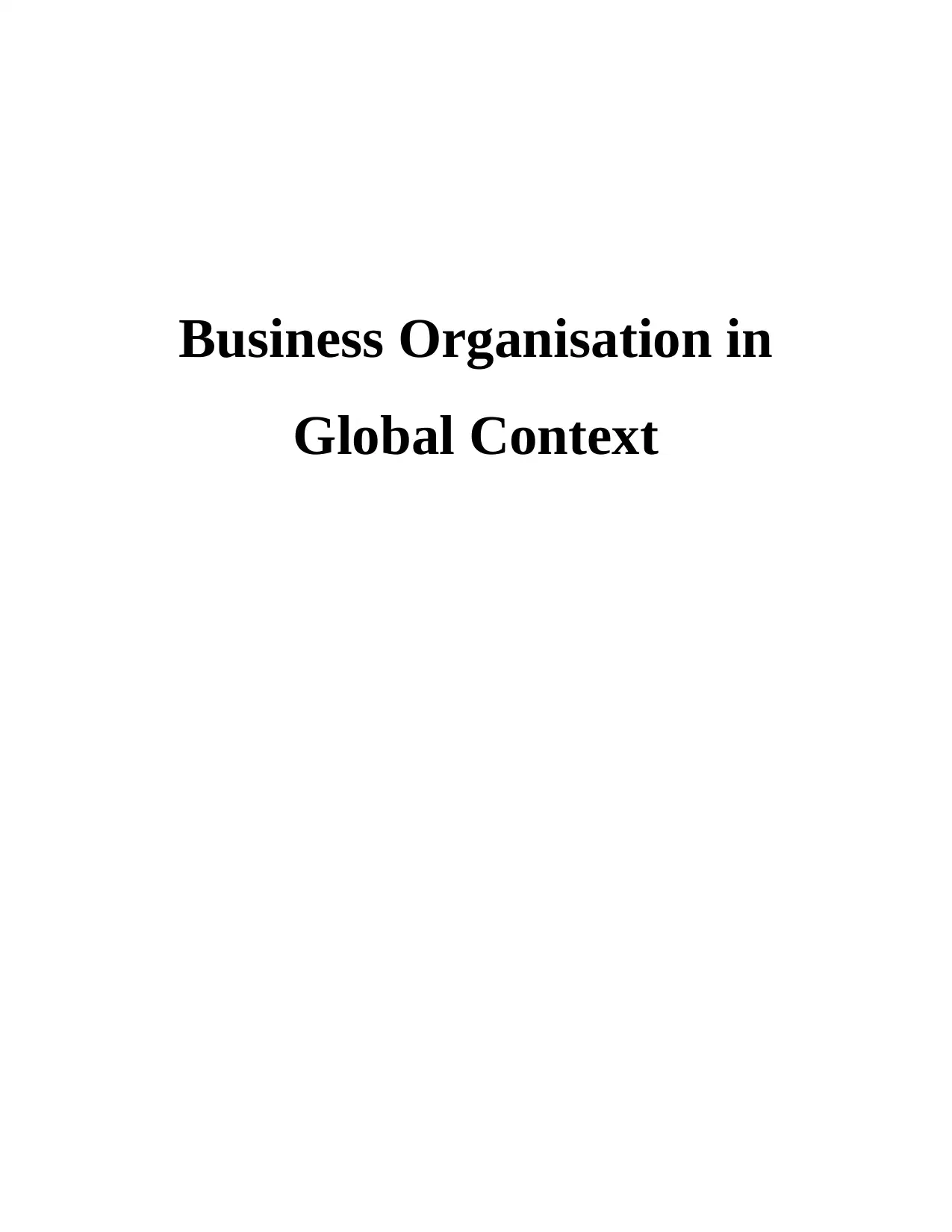
Business Organisation in
Global Context
Global Context
Secure Best Marks with AI Grader
Need help grading? Try our AI Grader for instant feedback on your assignments.
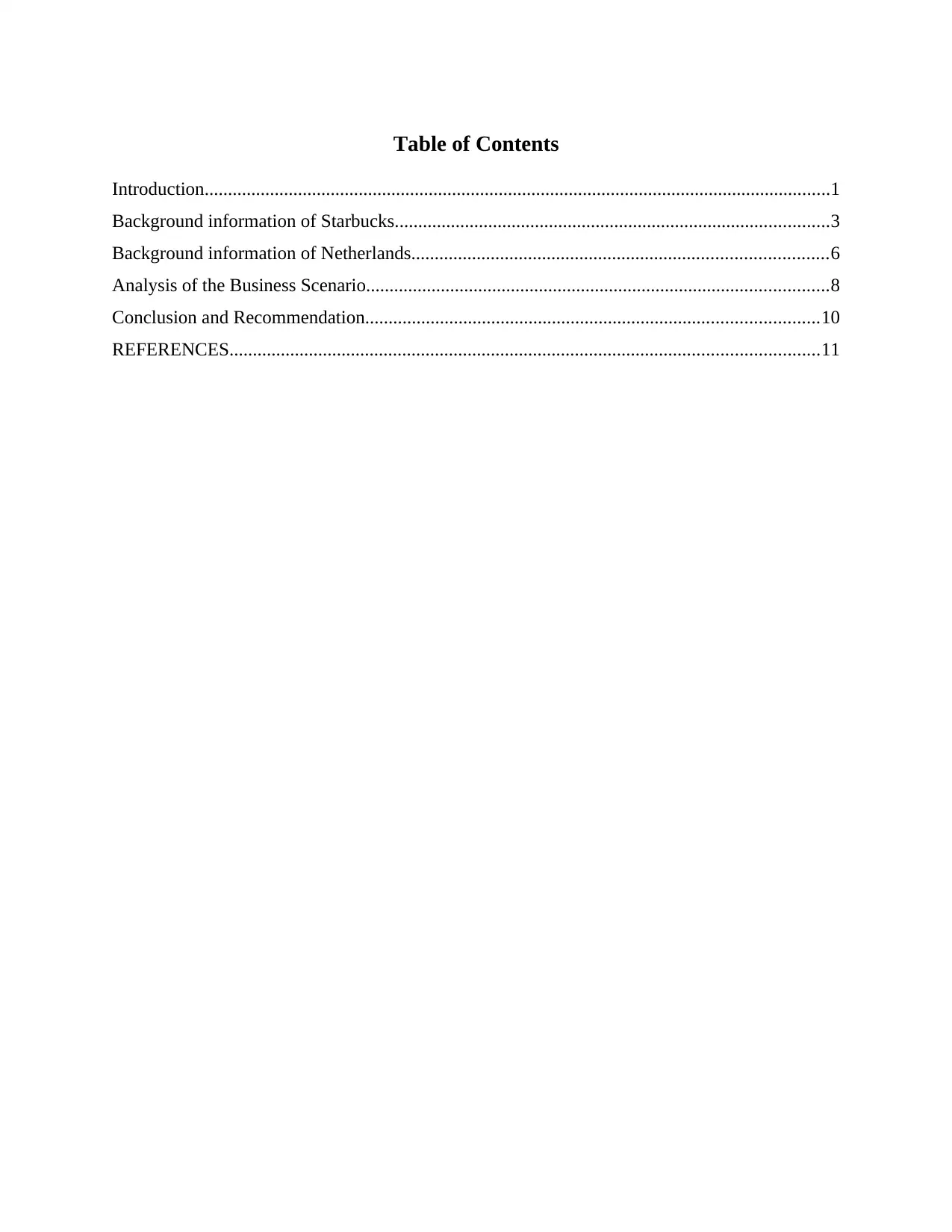
Table of Contents
Introduction......................................................................................................................................1
Background information of Starbucks.............................................................................................3
Background information of Netherlands.........................................................................................6
Analysis of the Business Scenario...................................................................................................8
Conclusion and Recommendation.................................................................................................10
REFERENCES..............................................................................................................................11
Introduction......................................................................................................................................1
Background information of Starbucks.............................................................................................3
Background information of Netherlands.........................................................................................6
Analysis of the Business Scenario...................................................................................................8
Conclusion and Recommendation.................................................................................................10
REFERENCES..............................................................................................................................11
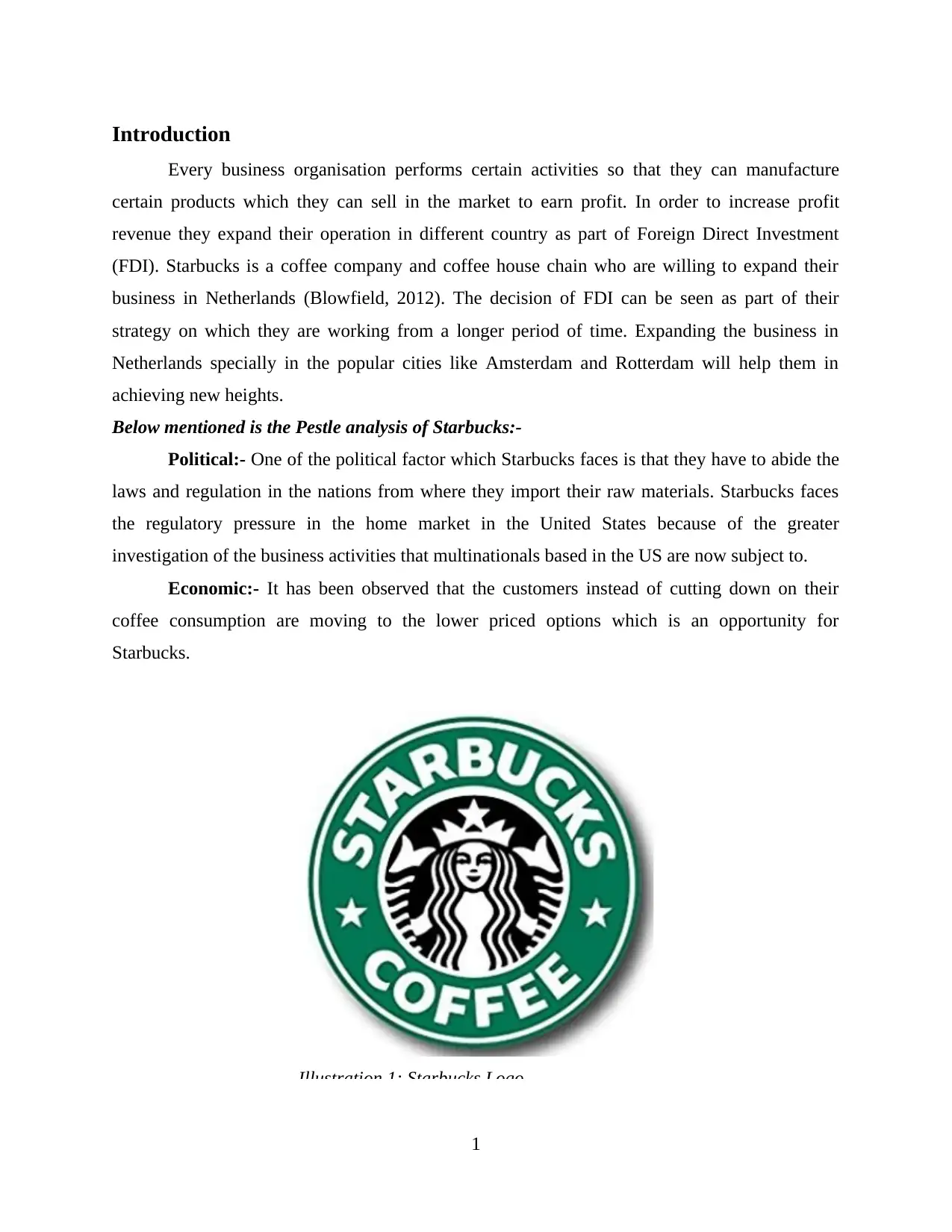
Introduction
Every business organisation performs certain activities so that they can manufacture
certain products which they can sell in the market to earn profit. In order to increase profit
revenue they expand their operation in different country as part of Foreign Direct Investment
(FDI). Starbucks is a coffee company and coffee house chain who are willing to expand their
business in Netherlands (Blowfield, 2012). The decision of FDI can be seen as part of their
strategy on which they are working from a longer period of time. Expanding the business in
Netherlands specially in the popular cities like Amsterdam and Rotterdam will help them in
achieving new heights.
Below mentioned is the Pestle analysis of Starbucks:-
Political:- One of the political factor which Starbucks faces is that they have to abide the
laws and regulation in the nations from where they import their raw materials. Starbucks faces
the regulatory pressure in the home market in the United States because of the greater
investigation of the business activities that multinationals based in the US are now subject to.
Economic:- It has been observed that the customers instead of cutting down on their
coffee consumption are moving to the lower priced options which is an opportunity for
Starbucks.
1
Illustration 1: Starbucks Logo
Every business organisation performs certain activities so that they can manufacture
certain products which they can sell in the market to earn profit. In order to increase profit
revenue they expand their operation in different country as part of Foreign Direct Investment
(FDI). Starbucks is a coffee company and coffee house chain who are willing to expand their
business in Netherlands (Blowfield, 2012). The decision of FDI can be seen as part of their
strategy on which they are working from a longer period of time. Expanding the business in
Netherlands specially in the popular cities like Amsterdam and Rotterdam will help them in
achieving new heights.
Below mentioned is the Pestle analysis of Starbucks:-
Political:- One of the political factor which Starbucks faces is that they have to abide the
laws and regulation in the nations from where they import their raw materials. Starbucks faces
the regulatory pressure in the home market in the United States because of the greater
investigation of the business activities that multinationals based in the US are now subject to.
Economic:- It has been observed that the customers instead of cutting down on their
coffee consumption are moving to the lower priced options which is an opportunity for
Starbucks.
1
Illustration 1: Starbucks Logo
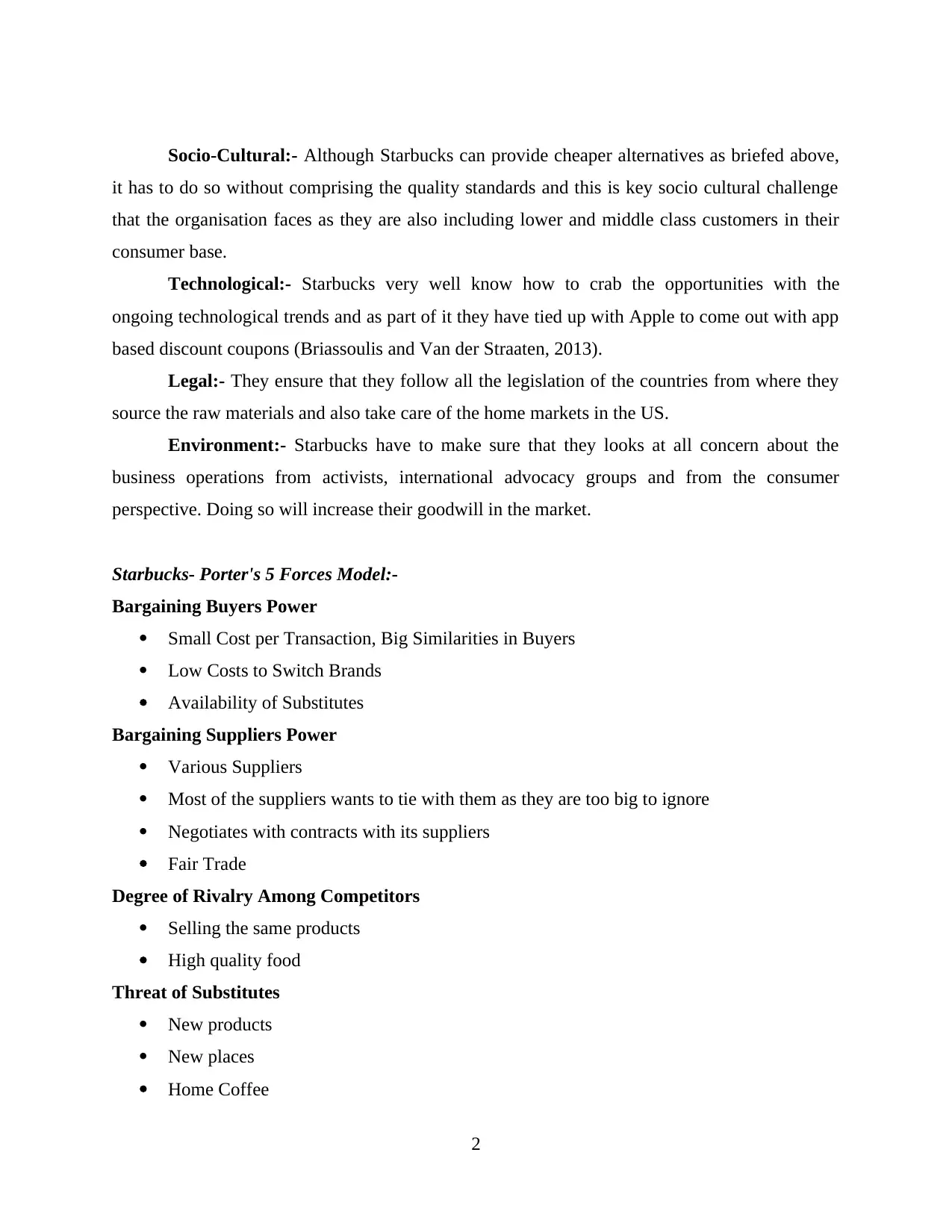
Socio-Cultural:- Although Starbucks can provide cheaper alternatives as briefed above,
it has to do so without comprising the quality standards and this is key socio cultural challenge
that the organisation faces as they are also including lower and middle class customers in their
consumer base.
Technological:- Starbucks very well know how to crab the opportunities with the
ongoing technological trends and as part of it they have tied up with Apple to come out with app
based discount coupons (Briassoulis and Van der Straaten, 2013).
Legal:- They ensure that they follow all the legislation of the countries from where they
source the raw materials and also take care of the home markets in the US.
Environment:- Starbucks have to make sure that they looks at all concern about the
business operations from activists, international advocacy groups and from the consumer
perspective. Doing so will increase their goodwill in the market.
Starbucks- Porter's 5 Forces Model:-
Bargaining Buyers Power
Small Cost per Transaction, Big Similarities in Buyers
Low Costs to Switch Brands
Availability of Substitutes
Bargaining Suppliers Power
Various Suppliers
Most of the suppliers wants to tie with them as they are too big to ignore
Negotiates with contracts with its suppliers
Fair Trade
Degree of Rivalry Among Competitors
Selling the same products
High quality food
Threat of Substitutes
New products
New places
Home Coffee
2
it has to do so without comprising the quality standards and this is key socio cultural challenge
that the organisation faces as they are also including lower and middle class customers in their
consumer base.
Technological:- Starbucks very well know how to crab the opportunities with the
ongoing technological trends and as part of it they have tied up with Apple to come out with app
based discount coupons (Briassoulis and Van der Straaten, 2013).
Legal:- They ensure that they follow all the legislation of the countries from where they
source the raw materials and also take care of the home markets in the US.
Environment:- Starbucks have to make sure that they looks at all concern about the
business operations from activists, international advocacy groups and from the consumer
perspective. Doing so will increase their goodwill in the market.
Starbucks- Porter's 5 Forces Model:-
Bargaining Buyers Power
Small Cost per Transaction, Big Similarities in Buyers
Low Costs to Switch Brands
Availability of Substitutes
Bargaining Suppliers Power
Various Suppliers
Most of the suppliers wants to tie with them as they are too big to ignore
Negotiates with contracts with its suppliers
Fair Trade
Degree of Rivalry Among Competitors
Selling the same products
High quality food
Threat of Substitutes
New products
New places
Home Coffee
2
Secure Best Marks with AI Grader
Need help grading? Try our AI Grader for instant feedback on your assignments.
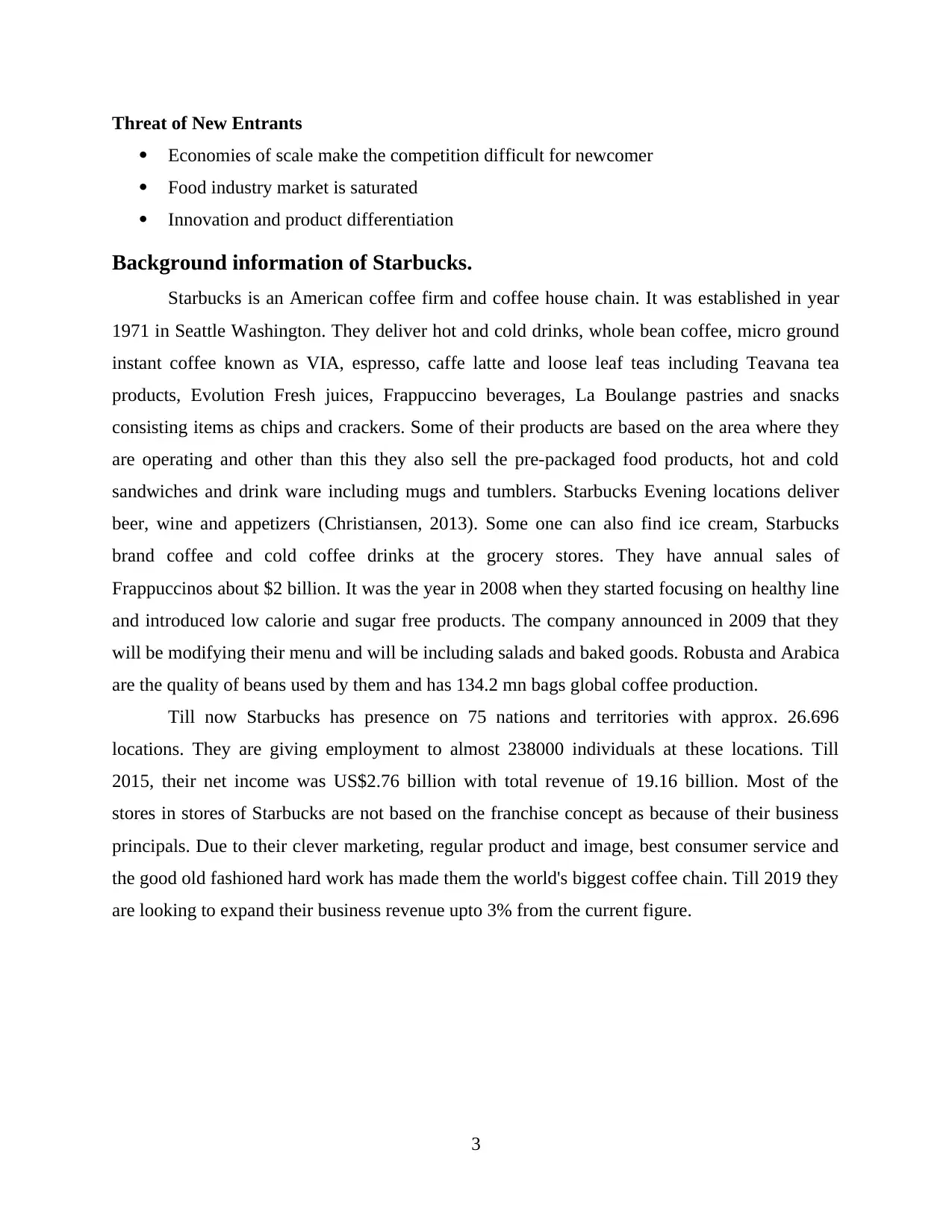
Threat of New Entrants
Economies of scale make the competition difficult for newcomer
Food industry market is saturated
Innovation and product differentiation
Background information of Starbucks.
Starbucks is an American coffee firm and coffee house chain. It was established in year
1971 in Seattle Washington. They deliver hot and cold drinks, whole bean coffee, micro ground
instant coffee known as VIA, espresso, caffe latte and loose leaf teas including Teavana tea
products, Evolution Fresh juices, Frappuccino beverages, La Boulange pastries and snacks
consisting items as chips and crackers. Some of their products are based on the area where they
are operating and other than this they also sell the pre-packaged food products, hot and cold
sandwiches and drink ware including mugs and tumblers. Starbucks Evening locations deliver
beer, wine and appetizers (Christiansen, 2013). Some one can also find ice cream, Starbucks
brand coffee and cold coffee drinks at the grocery stores. They have annual sales of
Frappuccinos about $2 billion. It was the year in 2008 when they started focusing on healthy line
and introduced low calorie and sugar free products. The company announced in 2009 that they
will be modifying their menu and will be including salads and baked goods. Robusta and Arabica
are the quality of beans used by them and has 134.2 mn bags global coffee production.
Till now Starbucks has presence on 75 nations and territories with approx. 26.696
locations. They are giving employment to almost 238000 individuals at these locations. Till
2015, their net income was US$2.76 billion with total revenue of 19.16 billion. Most of the
stores in stores of Starbucks are not based on the franchise concept as because of their business
principals. Due to their clever marketing, regular product and image, best consumer service and
the good old fashioned hard work has made them the world's biggest coffee chain. Till 2019 they
are looking to expand their business revenue upto 3% from the current figure.
3
Economies of scale make the competition difficult for newcomer
Food industry market is saturated
Innovation and product differentiation
Background information of Starbucks.
Starbucks is an American coffee firm and coffee house chain. It was established in year
1971 in Seattle Washington. They deliver hot and cold drinks, whole bean coffee, micro ground
instant coffee known as VIA, espresso, caffe latte and loose leaf teas including Teavana tea
products, Evolution Fresh juices, Frappuccino beverages, La Boulange pastries and snacks
consisting items as chips and crackers. Some of their products are based on the area where they
are operating and other than this they also sell the pre-packaged food products, hot and cold
sandwiches and drink ware including mugs and tumblers. Starbucks Evening locations deliver
beer, wine and appetizers (Christiansen, 2013). Some one can also find ice cream, Starbucks
brand coffee and cold coffee drinks at the grocery stores. They have annual sales of
Frappuccinos about $2 billion. It was the year in 2008 when they started focusing on healthy line
and introduced low calorie and sugar free products. The company announced in 2009 that they
will be modifying their menu and will be including salads and baked goods. Robusta and Arabica
are the quality of beans used by them and has 134.2 mn bags global coffee production.
Till now Starbucks has presence on 75 nations and territories with approx. 26.696
locations. They are giving employment to almost 238000 individuals at these locations. Till
2015, their net income was US$2.76 billion with total revenue of 19.16 billion. Most of the
stores in stores of Starbucks are not based on the franchise concept as because of their business
principals. Due to their clever marketing, regular product and image, best consumer service and
the good old fashioned hard work has made them the world's biggest coffee chain. Till 2019 they
are looking to expand their business revenue upto 3% from the current figure.
3
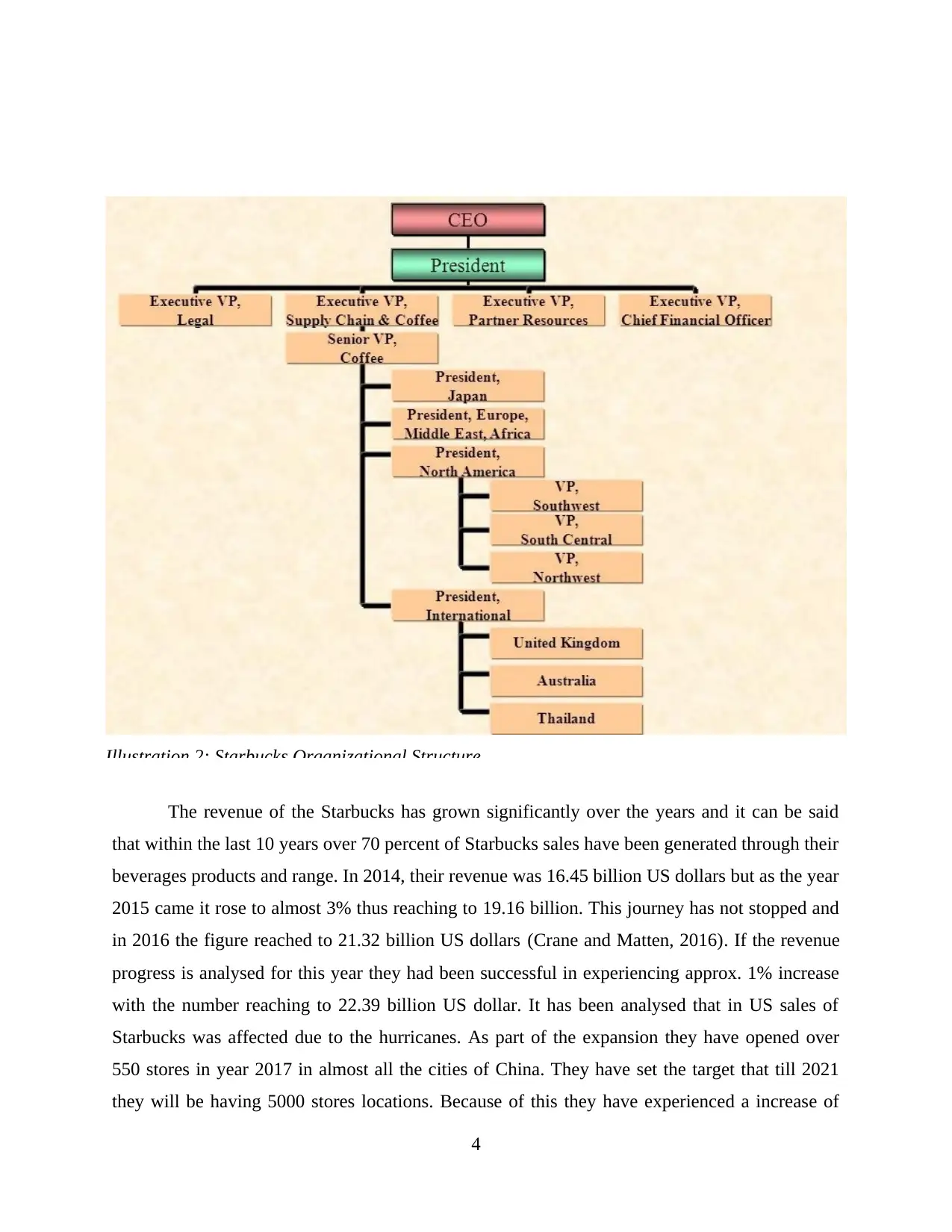
The revenue of the Starbucks has grown significantly over the years and it can be said
that within the last 10 years over 70 percent of Starbucks sales have been generated through their
beverages products and range. In 2014, their revenue was 16.45 billion US dollars but as the year
2015 came it rose to almost 3% thus reaching to 19.16 billion. This journey has not stopped and
in 2016 the figure reached to 21.32 billion US dollars (Crane and Matten, 2016). If the revenue
progress is analysed for this year they had been successful in experiencing approx. 1% increase
with the number reaching to 22.39 billion US dollar. It has been analysed that in US sales of
Starbucks was affected due to the hurricanes. As part of the expansion they have opened over
550 stores in year 2017 in almost all the cities of China. They have set the target that till 2021
they will be having 5000 stores locations. Because of this they have experienced a increase of
4
Illustration 2: Starbucks Organizational Structure
that within the last 10 years over 70 percent of Starbucks sales have been generated through their
beverages products and range. In 2014, their revenue was 16.45 billion US dollars but as the year
2015 came it rose to almost 3% thus reaching to 19.16 billion. This journey has not stopped and
in 2016 the figure reached to 21.32 billion US dollars (Crane and Matten, 2016). If the revenue
progress is analysed for this year they had been successful in experiencing approx. 1% increase
with the number reaching to 22.39 billion US dollar. It has been analysed that in US sales of
Starbucks was affected due to the hurricanes. As part of the expansion they have opened over
550 stores in year 2017 in almost all the cities of China. They have set the target that till 2021
they will be having 5000 stores locations. Because of this they have experienced a increase of
4
Illustration 2: Starbucks Organizational Structure
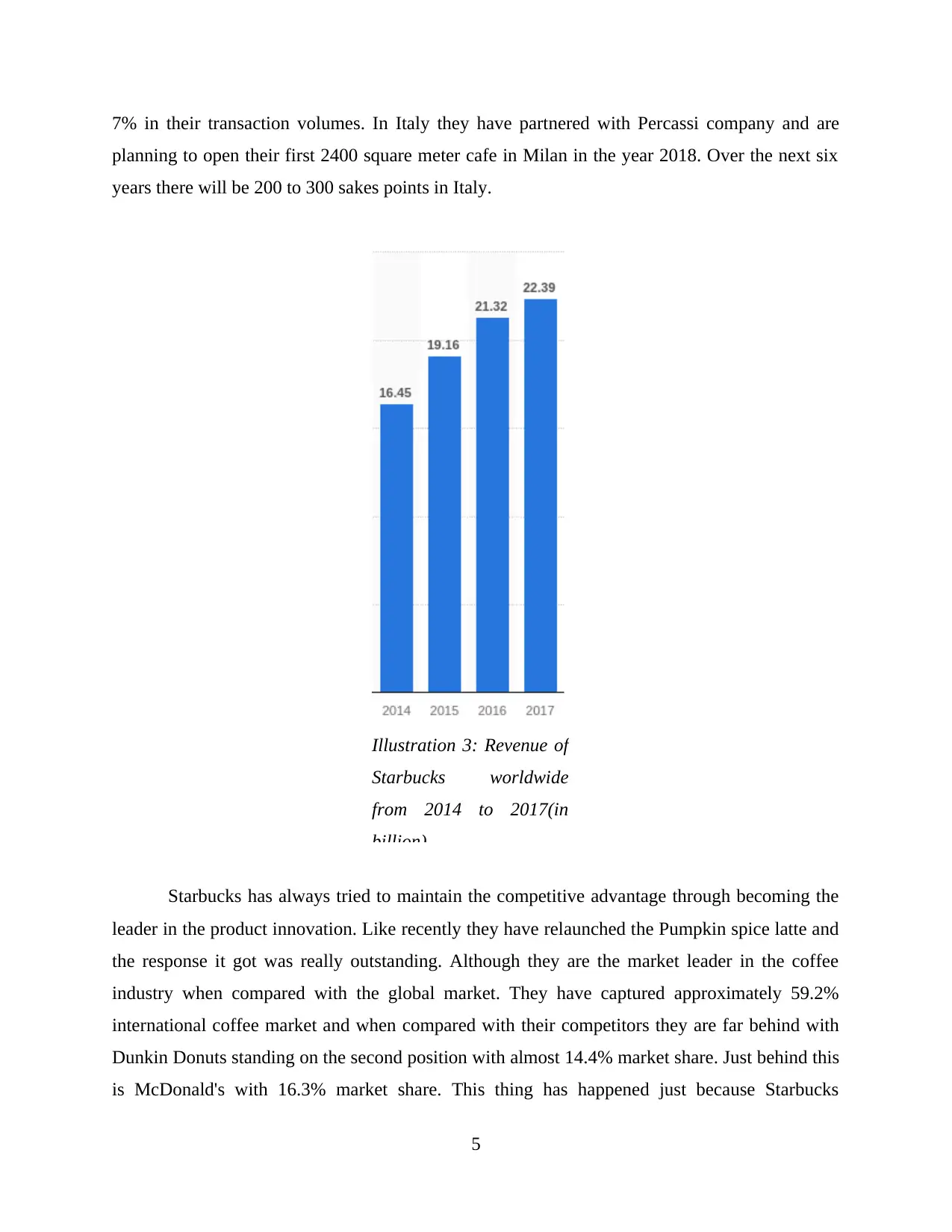
7% in their transaction volumes. In Italy they have partnered with Percassi company and are
planning to open their first 2400 square meter cafe in Milan in the year 2018. Over the next six
years there will be 200 to 300 sakes points in Italy.
Starbucks has always tried to maintain the competitive advantage through becoming the
leader in the product innovation. Like recently they have relaunched the Pumpkin spice latte and
the response it got was really outstanding. Although they are the market leader in the coffee
industry when compared with the global market. They have captured approximately 59.2%
international coffee market and when compared with their competitors they are far behind with
Dunkin Donuts standing on the second position with almost 14.4% market share. Just behind this
is McDonald's with 16.3% market share. This thing has happened just because Starbucks
5
Illustration 3: Revenue of
Starbucks worldwide
from 2014 to 2017(in
billion).
planning to open their first 2400 square meter cafe in Milan in the year 2018. Over the next six
years there will be 200 to 300 sakes points in Italy.
Starbucks has always tried to maintain the competitive advantage through becoming the
leader in the product innovation. Like recently they have relaunched the Pumpkin spice latte and
the response it got was really outstanding. Although they are the market leader in the coffee
industry when compared with the global market. They have captured approximately 59.2%
international coffee market and when compared with their competitors they are far behind with
Dunkin Donuts standing on the second position with almost 14.4% market share. Just behind this
is McDonald's with 16.3% market share. This thing has happened just because Starbucks
5
Illustration 3: Revenue of
Starbucks worldwide
from 2014 to 2017(in
billion).
Paraphrase This Document
Need a fresh take? Get an instant paraphrase of this document with our AI Paraphraser
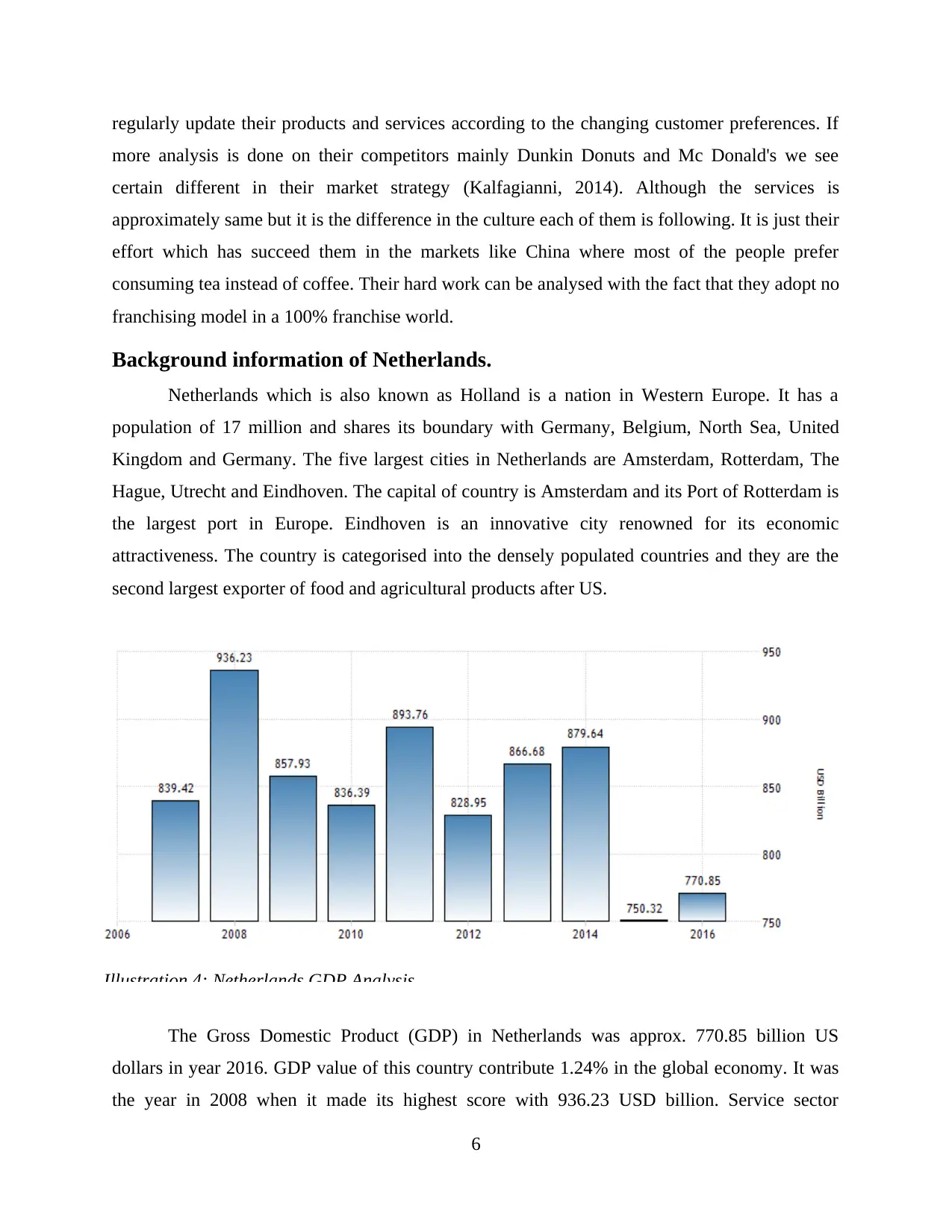
regularly update their products and services according to the changing customer preferences. If
more analysis is done on their competitors mainly Dunkin Donuts and Mc Donald's we see
certain different in their market strategy (Kalfagianni, 2014). Although the services is
approximately same but it is the difference in the culture each of them is following. It is just their
effort which has succeed them in the markets like China where most of the people prefer
consuming tea instead of coffee. Their hard work can be analysed with the fact that they adopt no
franchising model in a 100% franchise world.
Background information of Netherlands.
Netherlands which is also known as Holland is a nation in Western Europe. It has a
population of 17 million and shares its boundary with Germany, Belgium, North Sea, United
Kingdom and Germany. The five largest cities in Netherlands are Amsterdam, Rotterdam, The
Hague, Utrecht and Eindhoven. The capital of country is Amsterdam and its Port of Rotterdam is
the largest port in Europe. Eindhoven is an innovative city renowned for its economic
attractiveness. The country is categorised into the densely populated countries and they are the
second largest exporter of food and agricultural products after US.
The Gross Domestic Product (GDP) in Netherlands was approx. 770.85 billion US
dollars in year 2016. GDP value of this country contribute 1.24% in the global economy. It was
the year in 2008 when it made its highest score with 936.23 USD billion. Service sector
6
Illustration 4: Netherlands GDP Analysis
more analysis is done on their competitors mainly Dunkin Donuts and Mc Donald's we see
certain different in their market strategy (Kalfagianni, 2014). Although the services is
approximately same but it is the difference in the culture each of them is following. It is just their
effort which has succeed them in the markets like China where most of the people prefer
consuming tea instead of coffee. Their hard work can be analysed with the fact that they adopt no
franchising model in a 100% franchise world.
Background information of Netherlands.
Netherlands which is also known as Holland is a nation in Western Europe. It has a
population of 17 million and shares its boundary with Germany, Belgium, North Sea, United
Kingdom and Germany. The five largest cities in Netherlands are Amsterdam, Rotterdam, The
Hague, Utrecht and Eindhoven. The capital of country is Amsterdam and its Port of Rotterdam is
the largest port in Europe. Eindhoven is an innovative city renowned for its economic
attractiveness. The country is categorised into the densely populated countries and they are the
second largest exporter of food and agricultural products after US.
The Gross Domestic Product (GDP) in Netherlands was approx. 770.85 billion US
dollars in year 2016. GDP value of this country contribute 1.24% in the global economy. It was
the year in 2008 when it made its highest score with 936.23 USD billion. Service sector
6
Illustration 4: Netherlands GDP Analysis
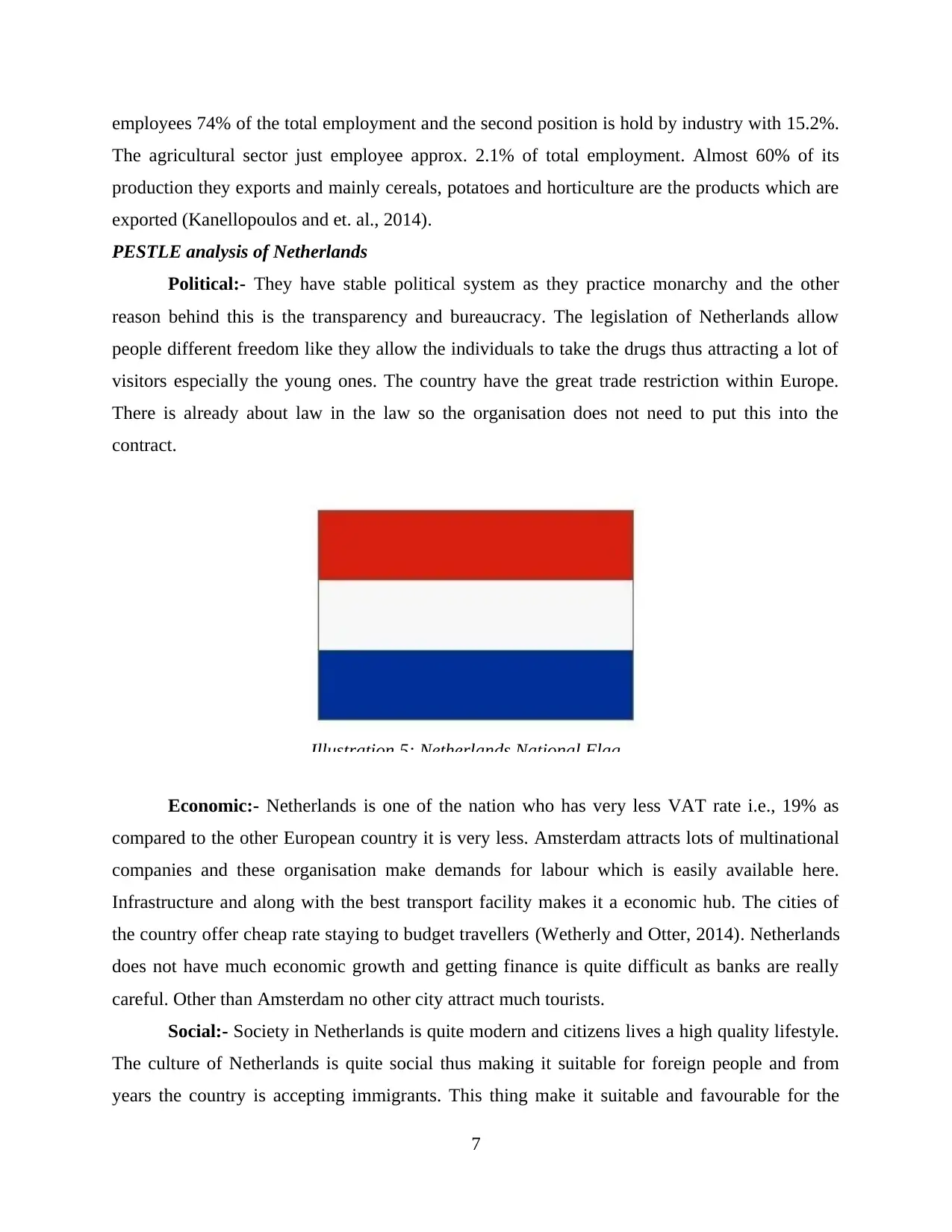
employees 74% of the total employment and the second position is hold by industry with 15.2%.
The agricultural sector just employee approx. 2.1% of total employment. Almost 60% of its
production they exports and mainly cereals, potatoes and horticulture are the products which are
exported (Kanellopoulos and et. al., 2014).
PESTLE analysis of Netherlands
Political:- They have stable political system as they practice monarchy and the other
reason behind this is the transparency and bureaucracy. The legislation of Netherlands allow
people different freedom like they allow the individuals to take the drugs thus attracting a lot of
visitors especially the young ones. The country have the great trade restriction within Europe.
There is already about law in the law so the organisation does not need to put this into the
contract.
Economic:- Netherlands is one of the nation who has very less VAT rate i.e., 19% as
compared to the other European country it is very less. Amsterdam attracts lots of multinational
companies and these organisation make demands for labour which is easily available here.
Infrastructure and along with the best transport facility makes it a economic hub. The cities of
the country offer cheap rate staying to budget travellers (Wetherly and Otter, 2014). Netherlands
does not have much economic growth and getting finance is quite difficult as banks are really
careful. Other than Amsterdam no other city attract much tourists.
Social:- Society in Netherlands is quite modern and citizens lives a high quality lifestyle.
The culture of Netherlands is quite social thus making it suitable for foreign people and from
years the country is accepting immigrants. This thing make it suitable and favourable for the
7
Illustration 5: Netherlands National Flag
The agricultural sector just employee approx. 2.1% of total employment. Almost 60% of its
production they exports and mainly cereals, potatoes and horticulture are the products which are
exported (Kanellopoulos and et. al., 2014).
PESTLE analysis of Netherlands
Political:- They have stable political system as they practice monarchy and the other
reason behind this is the transparency and bureaucracy. The legislation of Netherlands allow
people different freedom like they allow the individuals to take the drugs thus attracting a lot of
visitors especially the young ones. The country have the great trade restriction within Europe.
There is already about law in the law so the organisation does not need to put this into the
contract.
Economic:- Netherlands is one of the nation who has very less VAT rate i.e., 19% as
compared to the other European country it is very less. Amsterdam attracts lots of multinational
companies and these organisation make demands for labour which is easily available here.
Infrastructure and along with the best transport facility makes it a economic hub. The cities of
the country offer cheap rate staying to budget travellers (Wetherly and Otter, 2014). Netherlands
does not have much economic growth and getting finance is quite difficult as banks are really
careful. Other than Amsterdam no other city attract much tourists.
Social:- Society in Netherlands is quite modern and citizens lives a high quality lifestyle.
The culture of Netherlands is quite social thus making it suitable for foreign people and from
years the country is accepting immigrants. This thing make it suitable and favourable for the
7
Illustration 5: Netherlands National Flag
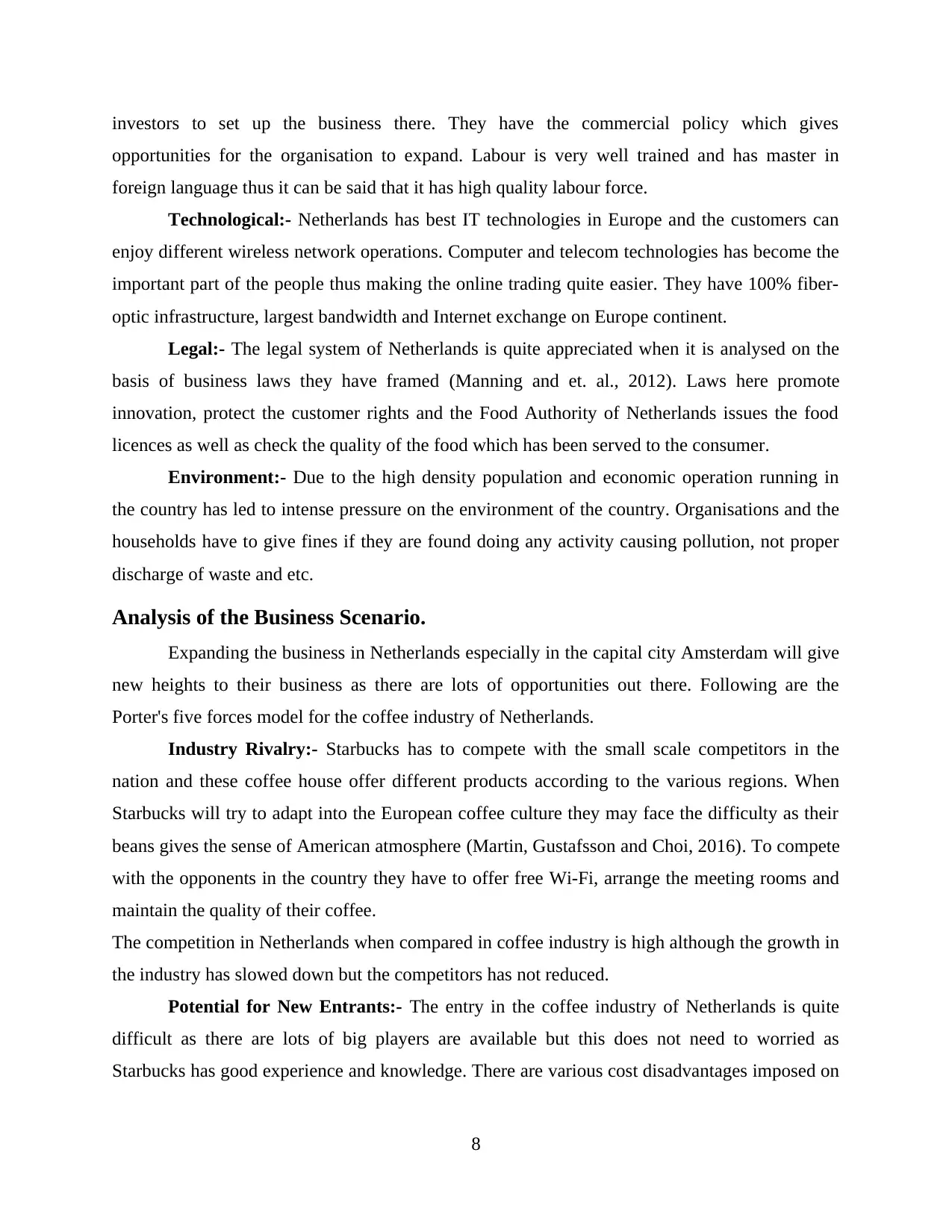
investors to set up the business there. They have the commercial policy which gives
opportunities for the organisation to expand. Labour is very well trained and has master in
foreign language thus it can be said that it has high quality labour force.
Technological:- Netherlands has best IT technologies in Europe and the customers can
enjoy different wireless network operations. Computer and telecom technologies has become the
important part of the people thus making the online trading quite easier. They have 100% fiber-
optic infrastructure, largest bandwidth and Internet exchange on Europe continent.
Legal:- The legal system of Netherlands is quite appreciated when it is analysed on the
basis of business laws they have framed (Manning and et. al., 2012). Laws here promote
innovation, protect the customer rights and the Food Authority of Netherlands issues the food
licences as well as check the quality of the food which has been served to the consumer.
Environment:- Due to the high density population and economic operation running in
the country has led to intense pressure on the environment of the country. Organisations and the
households have to give fines if they are found doing any activity causing pollution, not proper
discharge of waste and etc.
Analysis of the Business Scenario.
Expanding the business in Netherlands especially in the capital city Amsterdam will give
new heights to their business as there are lots of opportunities out there. Following are the
Porter's five forces model for the coffee industry of Netherlands.
Industry Rivalry:- Starbucks has to compete with the small scale competitors in the
nation and these coffee house offer different products according to the various regions. When
Starbucks will try to adapt into the European coffee culture they may face the difficulty as their
beans gives the sense of American atmosphere (Martin, Gustafsson and Choi, 2016). To compete
with the opponents in the country they have to offer free Wi-Fi, arrange the meeting rooms and
maintain the quality of their coffee.
The competition in Netherlands when compared in coffee industry is high although the growth in
the industry has slowed down but the competitors has not reduced.
Potential for New Entrants:- The entry in the coffee industry of Netherlands is quite
difficult as there are lots of big players are available but this does not need to worried as
Starbucks has good experience and knowledge. There are various cost disadvantages imposed on
8
opportunities for the organisation to expand. Labour is very well trained and has master in
foreign language thus it can be said that it has high quality labour force.
Technological:- Netherlands has best IT technologies in Europe and the customers can
enjoy different wireless network operations. Computer and telecom technologies has become the
important part of the people thus making the online trading quite easier. They have 100% fiber-
optic infrastructure, largest bandwidth and Internet exchange on Europe continent.
Legal:- The legal system of Netherlands is quite appreciated when it is analysed on the
basis of business laws they have framed (Manning and et. al., 2012). Laws here promote
innovation, protect the customer rights and the Food Authority of Netherlands issues the food
licences as well as check the quality of the food which has been served to the consumer.
Environment:- Due to the high density population and economic operation running in
the country has led to intense pressure on the environment of the country. Organisations and the
households have to give fines if they are found doing any activity causing pollution, not proper
discharge of waste and etc.
Analysis of the Business Scenario.
Expanding the business in Netherlands especially in the capital city Amsterdam will give
new heights to their business as there are lots of opportunities out there. Following are the
Porter's five forces model for the coffee industry of Netherlands.
Industry Rivalry:- Starbucks has to compete with the small scale competitors in the
nation and these coffee house offer different products according to the various regions. When
Starbucks will try to adapt into the European coffee culture they may face the difficulty as their
beans gives the sense of American atmosphere (Martin, Gustafsson and Choi, 2016). To compete
with the opponents in the country they have to offer free Wi-Fi, arrange the meeting rooms and
maintain the quality of their coffee.
The competition in Netherlands when compared in coffee industry is high although the growth in
the industry has slowed down but the competitors has not reduced.
Potential for New Entrants:- The entry in the coffee industry of Netherlands is quite
difficult as there are lots of big players are available but this does not need to worried as
Starbucks has good experience and knowledge. There are various cost disadvantages imposed on
8
Secure Best Marks with AI Grader
Need help grading? Try our AI Grader for instant feedback on your assignments.
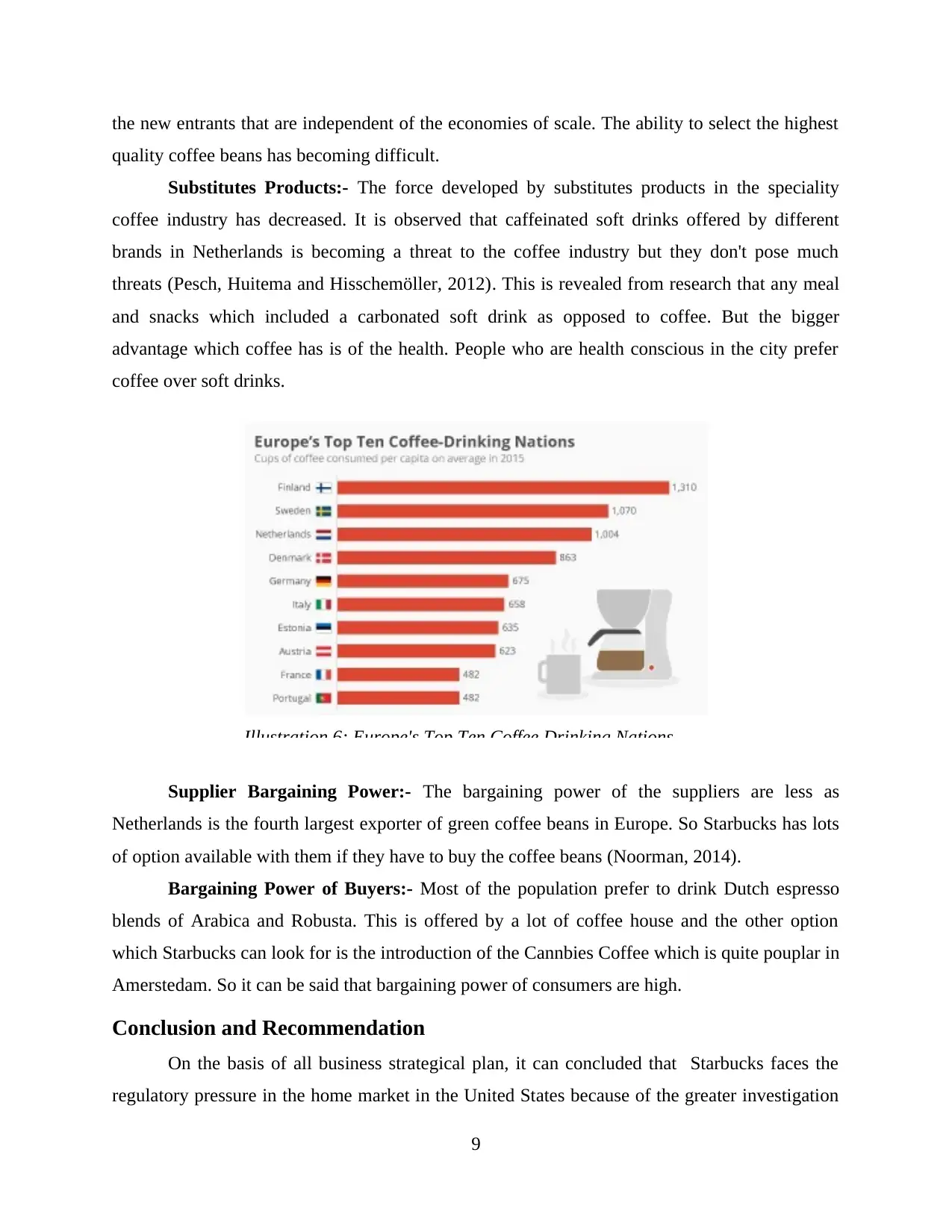
the new entrants that are independent of the economies of scale. The ability to select the highest
quality coffee beans has becoming difficult.
Substitutes Products:- The force developed by substitutes products in the speciality
coffee industry has decreased. It is observed that caffeinated soft drinks offered by different
brands in Netherlands is becoming a threat to the coffee industry but they don't pose much
threats (Pesch, Huitema and Hisschemöller, 2012). This is revealed from research that any meal
and snacks which included a carbonated soft drink as opposed to coffee. But the bigger
advantage which coffee has is of the health. People who are health conscious in the city prefer
coffee over soft drinks.
Supplier Bargaining Power:- The bargaining power of the suppliers are less as
Netherlands is the fourth largest exporter of green coffee beans in Europe. So Starbucks has lots
of option available with them if they have to buy the coffee beans (Noorman, 2014).
Bargaining Power of Buyers:- Most of the population prefer to drink Dutch espresso
blends of Arabica and Robusta. This is offered by a lot of coffee house and the other option
which Starbucks can look for is the introduction of the Cannbies Coffee which is quite pouplar in
Amerstedam. So it can be said that bargaining power of consumers are high.
Conclusion and Recommendation
On the basis of all business strategical plan, it can concluded that Starbucks faces the
regulatory pressure in the home market in the United States because of the greater investigation
9
Illustration 6: Europe's Top Ten Coffee Drinking Nations
quality coffee beans has becoming difficult.
Substitutes Products:- The force developed by substitutes products in the speciality
coffee industry has decreased. It is observed that caffeinated soft drinks offered by different
brands in Netherlands is becoming a threat to the coffee industry but they don't pose much
threats (Pesch, Huitema and Hisschemöller, 2012). This is revealed from research that any meal
and snacks which included a carbonated soft drink as opposed to coffee. But the bigger
advantage which coffee has is of the health. People who are health conscious in the city prefer
coffee over soft drinks.
Supplier Bargaining Power:- The bargaining power of the suppliers are less as
Netherlands is the fourth largest exporter of green coffee beans in Europe. So Starbucks has lots
of option available with them if they have to buy the coffee beans (Noorman, 2014).
Bargaining Power of Buyers:- Most of the population prefer to drink Dutch espresso
blends of Arabica and Robusta. This is offered by a lot of coffee house and the other option
which Starbucks can look for is the introduction of the Cannbies Coffee which is quite pouplar in
Amerstedam. So it can be said that bargaining power of consumers are high.
Conclusion and Recommendation
On the basis of all business strategical plan, it can concluded that Starbucks faces the
regulatory pressure in the home market in the United States because of the greater investigation
9
Illustration 6: Europe's Top Ten Coffee Drinking Nations
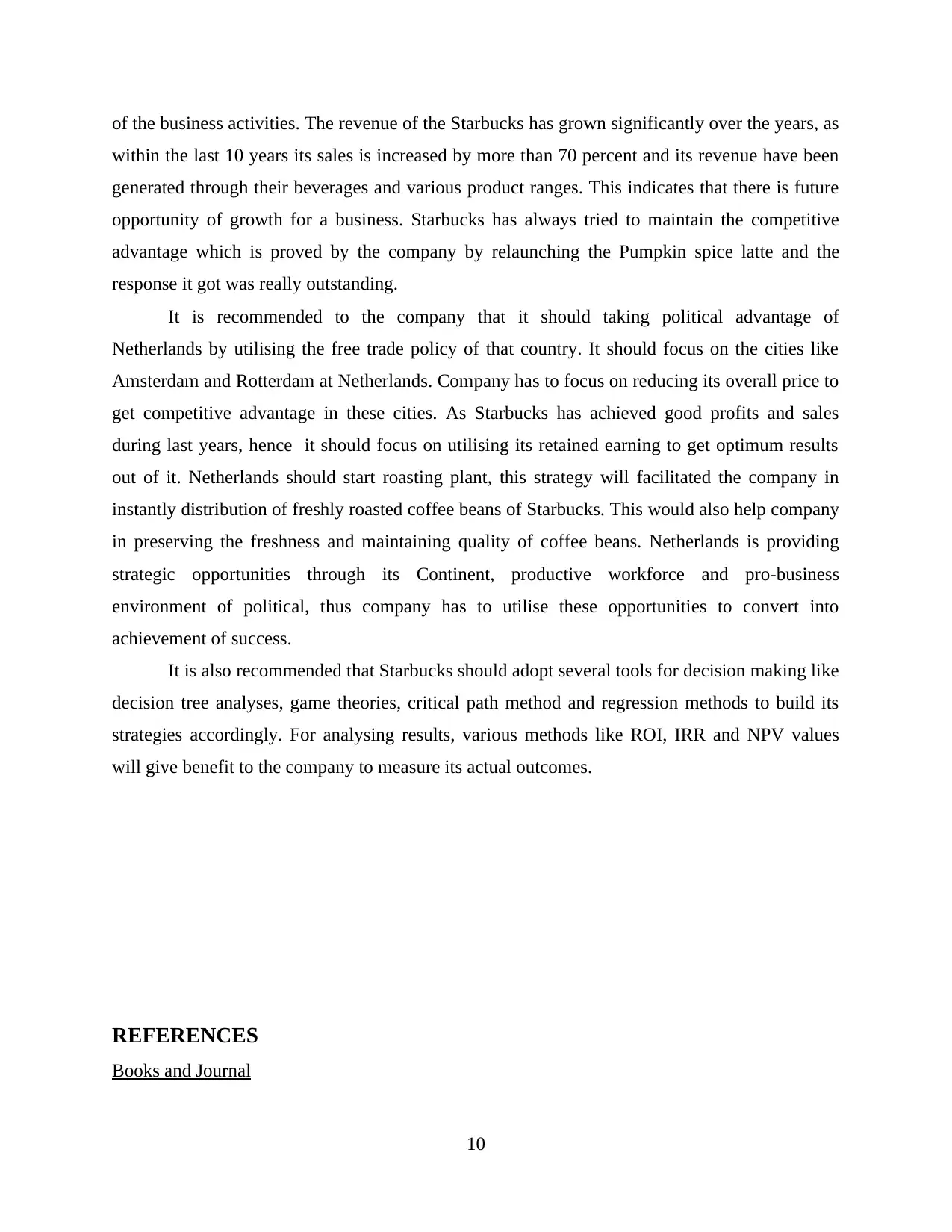
of the business activities. The revenue of the Starbucks has grown significantly over the years, as
within the last 10 years its sales is increased by more than 70 percent and its revenue have been
generated through their beverages and various product ranges. This indicates that there is future
opportunity of growth for a business. Starbucks has always tried to maintain the competitive
advantage which is proved by the company by relaunching the Pumpkin spice latte and the
response it got was really outstanding.
It is recommended to the company that it should taking political advantage of
Netherlands by utilising the free trade policy of that country. It should focus on the cities like
Amsterdam and Rotterdam at Netherlands. Company has to focus on reducing its overall price to
get competitive advantage in these cities. As Starbucks has achieved good profits and sales
during last years, hence it should focus on utilising its retained earning to get optimum results
out of it. Netherlands should start roasting plant, this strategy will facilitated the company in
instantly distribution of freshly roasted coffee beans of Starbucks. This would also help company
in preserving the freshness and maintaining quality of coffee beans. Netherlands is providing
strategic opportunities through its Continent, productive workforce and pro-business
environment of political, thus company has to utilise these opportunities to convert into
achievement of success.
It is also recommended that Starbucks should adopt several tools for decision making like
decision tree analyses, game theories, critical path method and regression methods to build its
strategies accordingly. For analysing results, various methods like ROI, IRR and NPV values
will give benefit to the company to measure its actual outcomes.
REFERENCES
Books and Journal
10
within the last 10 years its sales is increased by more than 70 percent and its revenue have been
generated through their beverages and various product ranges. This indicates that there is future
opportunity of growth for a business. Starbucks has always tried to maintain the competitive
advantage which is proved by the company by relaunching the Pumpkin spice latte and the
response it got was really outstanding.
It is recommended to the company that it should taking political advantage of
Netherlands by utilising the free trade policy of that country. It should focus on the cities like
Amsterdam and Rotterdam at Netherlands. Company has to focus on reducing its overall price to
get competitive advantage in these cities. As Starbucks has achieved good profits and sales
during last years, hence it should focus on utilising its retained earning to get optimum results
out of it. Netherlands should start roasting plant, this strategy will facilitated the company in
instantly distribution of freshly roasted coffee beans of Starbucks. This would also help company
in preserving the freshness and maintaining quality of coffee beans. Netherlands is providing
strategic opportunities through its Continent, productive workforce and pro-business
environment of political, thus company has to utilise these opportunities to convert into
achievement of success.
It is also recommended that Starbucks should adopt several tools for decision making like
decision tree analyses, game theories, critical path method and regression methods to build its
strategies accordingly. For analysing results, various methods like ROI, IRR and NPV values
will give benefit to the company to measure its actual outcomes.
REFERENCES
Books and Journal
10
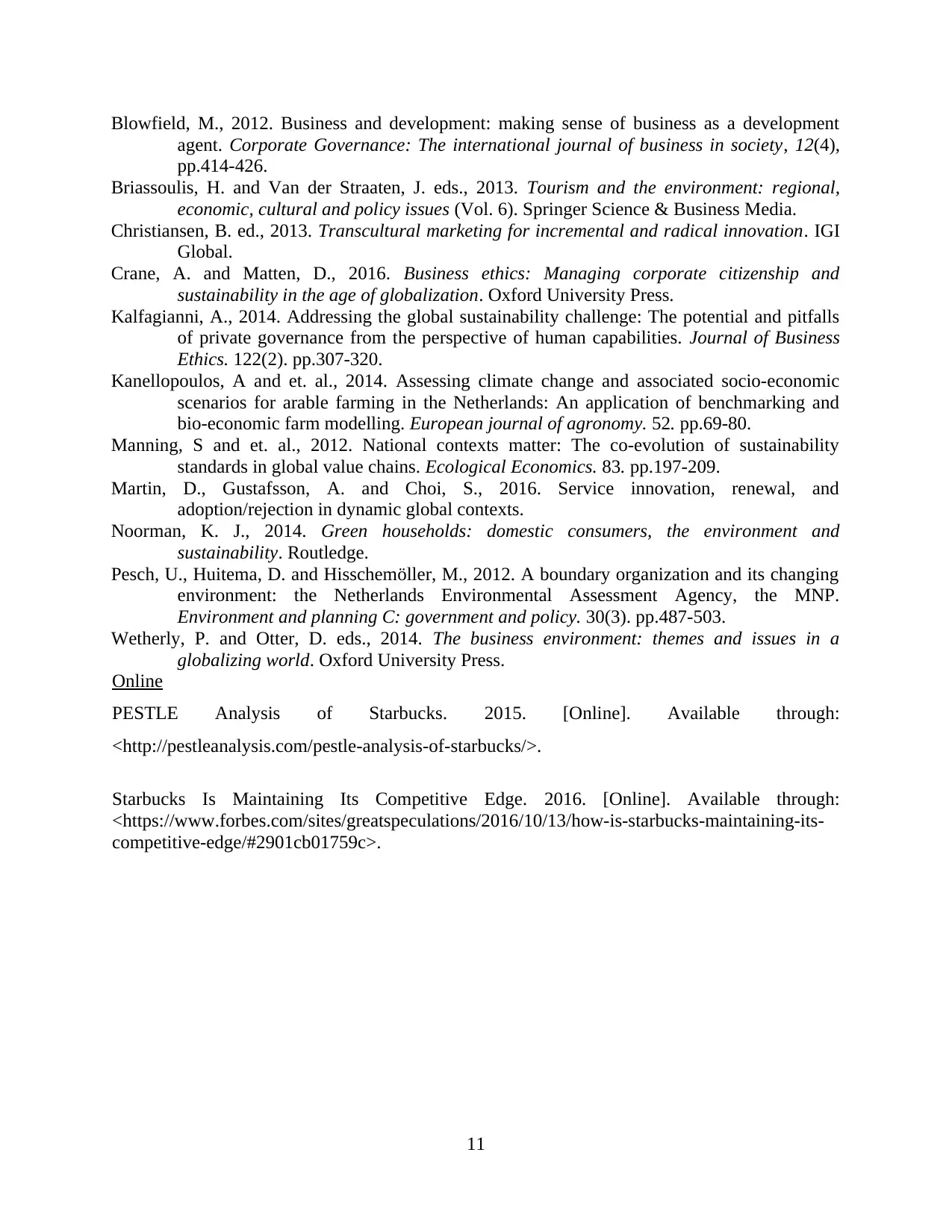
Blowfield, M., 2012. Business and development: making sense of business as a development
agent. Corporate Governance: The international journal of business in society, 12(4),
pp.414-426.
Briassoulis, H. and Van der Straaten, J. eds., 2013. Tourism and the environment: regional,
economic, cultural and policy issues (Vol. 6). Springer Science & Business Media.
Christiansen, B. ed., 2013. Transcultural marketing for incremental and radical innovation. IGI
Global.
Crane, A. and Matten, D., 2016. Business ethics: Managing corporate citizenship and
sustainability in the age of globalization. Oxford University Press.
Kalfagianni, A., 2014. Addressing the global sustainability challenge: The potential and pitfalls
of private governance from the perspective of human capabilities. Journal of Business
Ethics. 122(2). pp.307-320.
Kanellopoulos, A and et. al., 2014. Assessing climate change and associated socio-economic
scenarios for arable farming in the Netherlands: An application of benchmarking and
bio-economic farm modelling. European journal of agronomy. 52. pp.69-80.
Manning, S and et. al., 2012. National contexts matter: The co-evolution of sustainability
standards in global value chains. Ecological Economics. 83. pp.197-209.
Martin, D., Gustafsson, A. and Choi, S., 2016. Service innovation, renewal, and
adoption/rejection in dynamic global contexts.
Noorman, K. J., 2014. Green households: domestic consumers, the environment and
sustainability. Routledge.
Pesch, U., Huitema, D. and Hisschemöller, M., 2012. A boundary organization and its changing
environment: the Netherlands Environmental Assessment Agency, the MNP.
Environment and planning C: government and policy. 30(3). pp.487-503.
Wetherly, P. and Otter, D. eds., 2014. The business environment: themes and issues in a
globalizing world. Oxford University Press.
Online
PESTLE Analysis of Starbucks. 2015. [Online]. Available through:
<http://pestleanalysis.com/pestle-analysis-of-starbucks/>.
Starbucks Is Maintaining Its Competitive Edge. 2016. [Online]. Available through:
<https://www.forbes.com/sites/greatspeculations/2016/10/13/how-is-starbucks-maintaining-its-
competitive-edge/#2901cb01759c>.
11
agent. Corporate Governance: The international journal of business in society, 12(4),
pp.414-426.
Briassoulis, H. and Van der Straaten, J. eds., 2013. Tourism and the environment: regional,
economic, cultural and policy issues (Vol. 6). Springer Science & Business Media.
Christiansen, B. ed., 2013. Transcultural marketing for incremental and radical innovation. IGI
Global.
Crane, A. and Matten, D., 2016. Business ethics: Managing corporate citizenship and
sustainability in the age of globalization. Oxford University Press.
Kalfagianni, A., 2014. Addressing the global sustainability challenge: The potential and pitfalls
of private governance from the perspective of human capabilities. Journal of Business
Ethics. 122(2). pp.307-320.
Kanellopoulos, A and et. al., 2014. Assessing climate change and associated socio-economic
scenarios for arable farming in the Netherlands: An application of benchmarking and
bio-economic farm modelling. European journal of agronomy. 52. pp.69-80.
Manning, S and et. al., 2012. National contexts matter: The co-evolution of sustainability
standards in global value chains. Ecological Economics. 83. pp.197-209.
Martin, D., Gustafsson, A. and Choi, S., 2016. Service innovation, renewal, and
adoption/rejection in dynamic global contexts.
Noorman, K. J., 2014. Green households: domestic consumers, the environment and
sustainability. Routledge.
Pesch, U., Huitema, D. and Hisschemöller, M., 2012. A boundary organization and its changing
environment: the Netherlands Environmental Assessment Agency, the MNP.
Environment and planning C: government and policy. 30(3). pp.487-503.
Wetherly, P. and Otter, D. eds., 2014. The business environment: themes and issues in a
globalizing world. Oxford University Press.
Online
PESTLE Analysis of Starbucks. 2015. [Online]. Available through:
<http://pestleanalysis.com/pestle-analysis-of-starbucks/>.
Starbucks Is Maintaining Its Competitive Edge. 2016. [Online]. Available through:
<https://www.forbes.com/sites/greatspeculations/2016/10/13/how-is-starbucks-maintaining-its-
competitive-edge/#2901cb01759c>.
11
1 out of 13
Related Documents
Your All-in-One AI-Powered Toolkit for Academic Success.
+13062052269
info@desklib.com
Available 24*7 on WhatsApp / Email
![[object Object]](/_next/static/media/star-bottom.7253800d.svg)
Unlock your academic potential
© 2024 | Zucol Services PVT LTD | All rights reserved.




